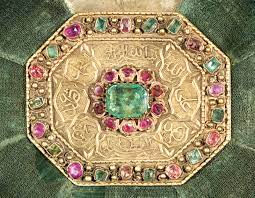


Antique Jewelry
Ottoman Period Jewelery Art
The Ottoman Empire was a major power in the world from the 14th century to the early 20th century, and during this time the art of jewelry flourished. Ottoman jewelry was famous for its intricate designs, exquisite craftsmanship and use of precious materials.
The Ottomans greatly valued jewelry as a symbol of wealth and power, and it was often used as a gift to foreign dignitaries or as a way of showing social status. The jewelry worn by Ottoman women was also an important part of their attire and often included elaborate headdresses, necklaces, bracelets and earrings.
Ottoman jewelers were skilled in various techniques such as filigree, granulation and cloisonne. They used a variety of materials, including gold, silver, diamonds, pearls, emeralds, rubies, and sapphires. Some of the pieces also included precious stones brought by trade from India and the Far East to the Ottoman Empire.
One of the most distinctive features of Ottoman jewelry was the use of calligraphy. Ottoman jewelers often added Arabic script to their designs to spell out religious verses or showcase the names of the sultan and other important figures.
Another important aspect of Ottoman jewelry is its symbolism. Many pieces were designed with specific meanings in mind, such as the tulip representing the Ottoman Empire or the evil eye bead believed to protect from bad luck.
In general, the art of goldsmithing during the Ottoman period was characterized by its excellent craftsmanship, intricate designs and the use of precious materials. It reflects the wealth and power of the Ottoman Empire and remains an important part of the cultural heritage of the region to this day.
Istanbul Izmir Antique
Armenian Jewelers
Armenian jewelers played an important role in the development of jewelry in the Ottoman period. These master goldsmiths were renowned for their craft and art, and their work was highly prized by wealthy clients throughout the Ottoman court and empire.
Armenian jewelry began to flourish in the 16th century when the Ottoman court was encouraged to create works of art for the sultan and other important figures. These jewelers usually worked in guilds where each guild specialized in a particular type or technique of jewellery.
One of the most famous Armenian jewelers of the Ottoman period is master craftsman Ohannes Amira Dadian, who was born in Istanbul in 1843. Known for its sophisticated designs and elegant craftsmanship, Dadian also produced jewelry for Ottoman courtiers. As wealthy customers in Europe and Asia. One of her most famous pieces is the gold and diamond necklace presented to Queen Victoria in 1876.
Another important Armenian jeweler of the Ottoman period is Hovsep Nalbandian, who was born in Istanbul in 1835. Nalbandian was known for his mastery of filigree craftsmanship as well as Ottoman calligraphy. His jewelry was highly valued in the Ottoman court, and he was rewarded with the title of "royal jeweler" for his talent and artistry.
Other Armenian jewelers of the Ottoman period include Sarkis Balian, who is known for his silver and gold work, and Hagop Kapudjian, who is known for his enamel work. These master jewelers helped shape the art of jewellery in the Ottoman period and created works that are still admired and envied today.


Greek Jewelery Masters
Greek jewelers also played a role during the Ottoman period, especially in the 18th and 19th centuries. Most of these jewelers were based in Istanbul, home to a large Greek community, and were known for their skill and expertise in jewellery.
One of the most famous Greek jewelers of the Ottoman period was Konstantinos Komnenos, who was born in Istanbul in 1778. Known for his excellent designs and craftsmanship, Komnenos created jewelry for Ottoman courtiers and wealthy customers all over Europe. and Asia. One of his most famous pieces is the diamond tiara commissioned by the Ottoman sultan for his daughter's wedding.
Another important Greek jeweler of the Ottoman period is Emmanuel Tzannis, who was born in Istanbul in 1833. Tzannis was known for his mastery of filigree and enamel craftsmanship, as well as using Ottoman calligraphy in his designs. His jewelry was highly valued in the Ottoman court, and he was rewarded with the title of "royal jeweler" for his talent and artistry.
Other Greek jewelers of the Ottoman period include Antonios Ekserdjian, known for his gold and silver craftsmanship, and Anastasios Michailidis, known for using precious stones in his designs. These master jewelers helped shape the art of jewellery in the Ottoman period and created works of art that are still admired and valued today.
It is worth noting that many of these Greek jewelers work in collaboration with Turkish artisans as well as Armenian and Jewish jewelers, and their work often reflects a mix of different cultural influences and styles.




